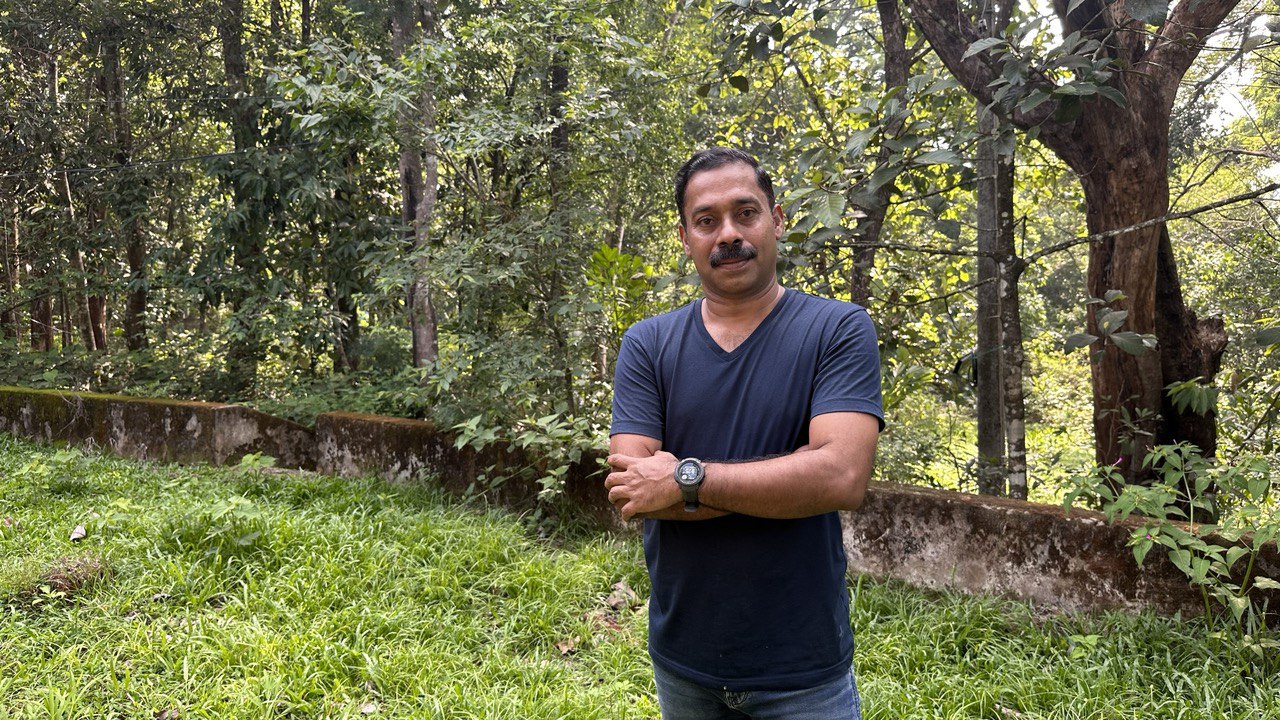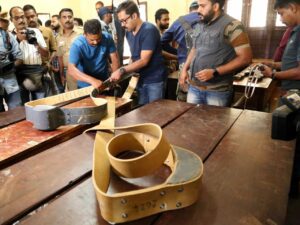The Wayanad-based Chief Veterinary Surgeon of the Kerala Forest Department is the go-to-man whenever the state faces wildlife-animal conflict.

Dr Arun Zakhariah. Photo: Shaju John
Kerala’s Chief Veterinary Surgeon Dr Arun Zachariah is a household name in the state, known even to children. For a generation that grew up reading James Herriot, he is a hero, much larger than the British vet and author. Still, some detest the surgeon — for carrying out orders issued to him with clinical precision.
For the Forest Department, he is the go-to-man when wildlife comes into conflict with humans. Passionate and chivalrous, he swings by troubled areas, attends to the problem, and returns to his veterinary clinic at Sulthan Bathery in the Wayanad Wildlife Sanctuary.
The 50-year-old veterinarian’s fame has transcended the state’s borders, and his advice is sought by neighbouring states as well. He is a mix of Herriot and Jim Corbett — qualities that have placed him on a high pedestal.

Dr Arun Zachariah with Dr Nisha Raichel, Assistant Forest Veterinary Surgeon in Munnar, ahead of capturing Arikomban. (Jomon Pampavalley)
Corbett had hunted 33 maneaters, besides tracking and shooting 19 tigers and four leopards. To his credit, Dr Zachariah has the national record of capturing and translocating 36 tigers, 63 elephants, and around 100 leopards that had posed a threat to human life and livelihoods across South India.
The latest was the capture and safe translocation of Arikomban, the around 35-year-old, ration shop-raiding wild tusker from Idukki’s Chinnakanal forests to Periyar.
South First caught up with Dr. Zachariah at his clinic in Wayanad. In a freewheeling conversation, he shared his experience, responsibilities, and views on wildlife.
Edited excerpts from the interview:
Q. Operation Arikomban has created many fans as well as enemies for you. Many animal rights activists, who hitherto justified your missions, have turned critics. They accuse you of administrating a tranquiliser overdose to the animal. They allege that the elephant was badly injured while being captured and taken to the Periyar Tiger Reserve. Your comment?

Dr. Arun Zachariah and his team inspecting the radio collar before darting Arikomban. The elephant was radio-collared before it was released. (Joman Pampavalley)
A. This is absolute nonsense. Who told them I administered an overdose? The entire process of capturing and releasing Arikomban took two days. He was released in the Periyar reserve 13 hours after his capture. I had to ensure the safety of the animal and those involved in the mission until it was released into the Periyar Tiger Reserve. So I administered tranquillisers and their boosters very carefully, and not even a single excess dose was given.
You might have noticed the difficult and sloped terrain of Chinnakanal, where capturing and relocating a charging elephant safely is risky. We were under enormous pressure, but we went by the textbook. Boosters were administered scientifically while the animal was being transported by road. Imagine the situation on the road if the tusker came out of sedation and responded violently.
As forest veterinarians, we have clear-cut procedures and methodologies. I have always followed the fundamentals ethically. Those who make allegations are not subject experts. They are beating around the bush.
Q. Is Arikomban now safe? What about the injuries he sustained? Reports say he is roaming the Meghamalai forest region of Tamil Nadu. Will he return to Chinnakanal?
A. We are closely monitoring his movements. I am sure he is healthy. The minor injuries have healed. Our operation did not cause the injuries. He might have sustained those injuries in a fight with other elephants.
Elephants are known to walk long distances. Arikomban is now exploring his new home. There are many positive factors there for Arikomban. The food chain is strong within the forest. Meghamalai is an extension of Periyar, and elephants have no state borders. It may take more time for him to adjust to the new situation.
But I cannot say Arikomban won’t return to Chinnakanal. There are possibilities. Many translocated elephants have returned to their original habitat by sometimes walking more than 450 km.
Q. The initial plan was to capture Arikomban and take him to the Kodanad elephant training centre. The authorities wanted him as a kumki (trainer) elephant that would help capture similar elephants. Was it a good move? Are third-degree methods used to tame aggressive elephants and convert them into kumkis?
A. All this is false propaganda. There is no third-degree torture in our elephant camps. You can see for yourself what is happening there. We have two elephant training camps in Kerala, and both are in a semi-forest environment. We don’t harm them. There is no torture. We train them scientifically.
They continue to remain in a semi-wild atmosphere. During the daytime, they move around in the nearby forests. They are being used as kumki elephants to assist in capturing and relocating trouble-causing elephants. Each such elephant would be under trained mahouts and expert veterinarians. Mahouts are trained scientifically and are barred from causing any physical harm to the elephants.
Q. This is one question many would like to ask: Who are you? An animal lover with respect for animal rights, or a forest veterinarian who goes by the book?
A. My affinity towards wild animals began during my high school days. I started reading about them. I wanted to be with them.
For graduation, I took zoology and then opted for veterinary science. Wildlife is my passion and commitment. I love them and prefer to be with them. About escalating human-animal conflicts, they are not Kerala-specific. It’s happening across the world.
Sometimes, we have to capture and keep troublesome elephants in kraals (wooden enclosures). There is no cruelty involved. Kraals are not concentration camps. Depending on the situation and possibilities, we will explore solutions. The best solution would be implemented.
Q. Is it wise to capture and translocate a herd’s leader? It is said that the rest of the herd would choose a new leader and continue its destructive activities. Is translocation a sheer waste of time and energy?
A. We have a proven record to counter this allegation. It’s a wrong campaign. Herds do not elect new leaders once the existing leader is translocated. Instead, they start behaving.
Eight years ago, there were protests against the tusker Kallur Komban, who was leading an eight-elephant herd that used to raid agricultural fields, apart from destroying small houses and buildings. We captured him and lodged him in a training camp. The issue ended there. The rest of the herd lost its violent streak. Now nobody complains about that herd. They are co-existing. Kallur Komban is now Bharat, and he was among the three kumkis that were involved in capturing and relocating Arikomban.
Q. Why are wild animals moving out of the forests?
A. There are multiple reasons, and habitat destruction is one of them. Climate change is affecting food security inside the forests. The food cycle gets affected, and there is a water crisis as well. Many human factors, too, are aggravating climate change-induced impacts on animals.
Invasive species like senna and lantena thrive in the forests, affecting flora and fauna. Many elephant corridors and traditional migratory paths have been destroyed or encroached on. Many such burning issues require policy-level changes. Animals and forests are vital to the survival of humans. We need our forests. Without them, we will not survive.
Q. Why are Wayanad and Idukki turning into hotspots of human-animal conflicts?
A. There are many reasons, as I explained. But there are some other issues we need to take into account.
A tiger was located in a human settlement in Wayanad for the first time in 2012. It was captured by the Karnataka Forest Department and released close to our border at Tholpetty.
The Tamil Nadu Forest Department captured rogue tusker PM-2 from the Nilgiris district and released it close to the Wayanad border. It moved into forests near Sulthan Bathery and posed a threat to farmers for about four years. Finally, we had to capture and put him in a training camp.
In the case of tigers, those aged and incapable of hunting are moving to human habitats looking for easy targets. Wounded animals are also looking for prey in forest-fringe villages. In Wayanad and several other hilly regions of Kerala, there are defunct estates and plantations.
They remain locked for many years and have more food for wild animals than the actual forests. It is why elephants are camping in such estates, posing a threat to the people living around them. They will not go away.
Q. There are huge risks involved in your profession. Also, the stress during capture and relocation operations is extremely high. How do you cope with such situations?
A. A colleague died in a tiger attack during a rescue operation. I have also been attacked by tigers, and once had a narrow escape.
The stress is high, especially when we add the risk of operating in difficult terrain. But once it is completed, I am a happy man. Seeing translocated wild animals recover and adjust to new territories brings me joy and satisfaction. If we had not conducted the rescue operation, the elephant in question might have been killed by anti-socials.
We captured Arikomban, PM-2, and another elephant, PT-7, which wreaked havoc in Palakkad’s Dhoni, to save them from criminal elements trying to harm them. As an elephant doctor, I must protect them.
I insist on bare minimum pressure on the animals while being translocated. I view my work as a conservation activity that has dangers. As you said, I carry the dart gun instead of the revolver. I am not formally trained in shooting, and I don’t shoot for the pleasure of hunting, but I do it for the collective good of wild and human life.
In a way, my family is an extended animal family. We have many members in the same profession. My wife, brother, and brother’s wife are all veterinary doctors, all drawn to wildlife and forests.
Q. Do tranquilisers affect the health of elephants?
A. We administered five tranquiliser shots to Arikomban. We administered the doses in such a way that Arikomban would be able to stand in the lorry while being translocated. In each case, there are procedures. We are not administering tranquilisers in excess. So the question of affecting their health does not arise.
Q. Could you provide a brief account of your career?
A. I hail from Manassery near Mukkam in the Kozhikode district. I began my career in the Forest Department at Muthanga in Wayanad as an assistant veterinary officer.
I studied at the College of Forestry of the Kerala Agriculture University and the London Veterinary College. I have a quarter-century of experience working with the Forest Department. The journey of a wildlife veterinarian is always exhausting, but the results keep me going.
Capturing a cornered carnivore is always risky, and it is riskier if a large crowd of onlookers gathers at the site. If the dart misses the target, the animal will escape and there will be no option other than to kill it. So far, I haven’t faced such a situation despite handling many tigers and leopards. My job requires the ability to predict the possible behaviour of animals. However, such predictions need not be always accurate.
Q. When was the first time you treated a wild animal?
A. My first encounter with a wild animal happened within days of joining the department at Muthanga. A young bull elephant had one of his forelimbs fractured in an unsupervised gunshot. I had zero experience in handling the old Danish guns available back then.
With my limited knowledge gained from textbooks, I ventured out to tranquillise him, which I did. I camped in the forest for about 10 days to cure the young elephant.
Once the swelling on his fractured leg subsided, I released him. He tried to stand on his own, but I heard a loud cracking sound. I was disappointed to see the elephant collapsing in front of me.
Forest Veterinary still lacks enough authentic books. So we rely on observation and experience. Through observation, I found it is almost impossible for elephants to survive with one injured leg. Free-ranging wildlife medicine is way too challenging and risky compared to zoo medicine, where you get a confined medical environment and the animal’s medical history.
Q. Have you ever been in a life-threatening situation?
A. There was one in 2013. I was supposed to capture a tiger that had strayed into a human habitat. Only after reaching Nayakkatti, a forest fringe village in Wayanad, did I realised the seriousness of the task.
The tiger was a massive one. If healthy tuskers raid plantations and crops, the weakest of tigers venture out to the forest’s peripheries for prey. They would be outcasts, mostly because of injuries or old age.
This cat was severely injured. The moment it spotted us, it pounced upon us. While others managed to merge with the crowd of onlookers, the tiger pushed me down, grabbed my chest , and growled. Somehow I managed to push my gun into its mouth and tranquilised it.
Tranquillising or shooting sick wild animals is the primary phase in wildlife medicine. People are fascinated by the adventure or the sports value of shooting rather than the real, challenging process of treatment that lies ahead.
Q. What are your other focus areas?
A. I have headed the Kerala Forest Department’s radio-collar project, which aims at attaching electronic tracking systems to rogue animals. The first radio-collared elephant in the state was an adult tusker which had wreaked havoc in Kozhikode’s Banursery. I captured it after a face-to-face conflict.
Later, I attached radio collars to panthers, tigers , and leopards that had ventured into human settlements. I was part of the expert committee constituted to capture bats from wells and tall trees in Kozhikode, during the Nipah outbreak in 2018. I was also a member of the multidisciplinary committee constituted by the government to locate the exact source of the Nipah virus outbreak.
Disease ecology is one area I am very much curious about. I study the pattern of diseases, viruses, bacteria , and germs in wild animals, and formulate hypotheses regarding their source, propagation, and ecology.
I headed the team which discovered tuberculosis among wild elephants and how the virus was transferred to them from humans. I also spotted EHV (Equine Herpes Virus) disease among animals in the Wayanad Wildlife Sanctuary.

Jul 26, 2024

Jul 26, 2024

Jul 25, 2024

Jul 25, 2024

Jul 25, 2024

Jul 24, 2024